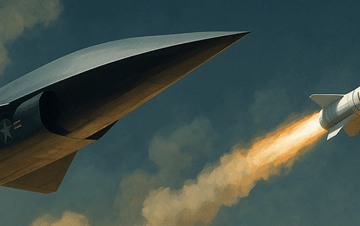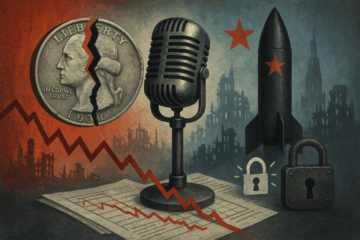With the release of the National Security Strategy (NSS), National Defense Strategy (NDS), and Nuclear Posture Review(NPR) in October 2022, we now have enough time and distance from their publication to evaluate the Biden administration’s long-awaited look at its view toward nuclear weapons and the nation’s two primary threats Russia and China. With Russia waiting for Ukraine to launch a major offensive and China engaging in aggressive action against Taiwan on a daily basis, making sure the Nuclear Posture Review gets it right is perhaps more important than ever.
Since its publication last fall, few foreign policy analysts would argue the world is more secure than it was then. In fact, they would likely argue just the opposite. Blaming the current state of affairs on the NPR would be unfair, but to some, there are key attributes of the NPR that led to more instability than security. To better understand these concerns, let us revisit some key points in the document.
What It Says
The NPR opens by suggesting that “nuclear deterrence is foundational to broader US defense strategy and the extended deterrence commitments that we have made to allies and partners.” Readers are also informed that the government is committed to disarmament obligations under the Treaty on the Non-Proliferation of Nuclear Weapons (NPT).
Due recognition is given to the fact that our principal adversaries (Russia, China, and North Korea) are expanding and diversifying their nuclear and non-nuclear arsenals, which is necessitating the United States replace its legacy nuclear weapons. The Nuclear Posture Review (2022) then gets to the heart of the Biden administration’s plan.
This plan includes: adopting a strategy and policy that sets a high bar for nuclear employment; adopting integrated deterrence; eliminating the “hedge against an uncertain future”; strengthening extended deterrence and allied assurance; pursuing arms control, strategic stability, and nonproliferation; reducing the risk of miscalculation; full-scope triad replacement and modernization of nuclear command, control, and communications (NC3); retirement of the B83-1 gravity bomb; and cancellation of the nuclear submarine-launched cruise missile (SLCM-N).
The Nuclear Posture Review then turns to the threat posed by Russia and China. According to the administration, by some point in the 2030s the United States will face two nuclear peer competitors or potential adversaries. The changing security environment poses four challenges to deterrence: (1) there is a heightened risk of nuclear weapons use; (2) China is fielding a peer nuclear arsenal; (3) opportunistic aggression is creating deterrence challenges; and (4) multi-domain challenges, which we do not fully understand, are proving challenging.
The Nuclear Posture Review then details the role of nuclear weapons in American strategy. It makes three points: nuclear weapons exist to deter strategic attacks directed against the homeland and allies and partners, nuclear weapons exist to assure allies and partners of American commitment, and nuclear forces exist to achieve American objectives if deterrence fails.
The document then shifts to tailored strategies or “Country-Specific Approaches.” What appears here is a strategy statement that indicates America’s biggest concern is Russia and China. North Korea is recognized as a threat which, should Kim Jung Un use nuclear weapons “will result in the end of that regime.” It is clear that the United States remains committed to nuclear deterrence in Europe. The same is true for the Indo-Pacific, with the American focus shifting there.
Whether through naivete or simple hope, the United States will continue honoring New START treaty commitments while Russia does not. With New START expiring in 2026, the Biden administration desires to negotiate a new arms control treaty, in spite of the clear evidence, even then, that Russia had different desires.
It is only later in the NPR that a discussion of nuclear modernization takes place. On the positive side, the administration calls for making dual-capable aircraft (F-35) ready to carry the B61-12 gravity bomb; fielding the Columbia-class ballistic missile submarine, the B21 bomber, and the Sentinel intercontinental ballistic missile; modernizing the NC3 system; and modernizing the weapons complex.
Finally, the Nuclear Posture Review examines the need to refurbish the nuclear stockpile. The Department of Defense and National Nuclear Security Administration (NNSA) are called to improve coordination for development and refurbishment of nuclear systems, with NNSA improving production of weapons components required for the short term and beyond.
Six Months later…What Does the NPR Get Right?
The 2022 Nuclear Posture Review gets three things right. First, it does not make “no first use” or “sole purpose” the nuclear policy of the United States. This was a wise decision. Such a decision recognizes that in the current security environment the actions of Russia, China, or North Korea may necessitate a nuclear response to a non-nuclear action. With threats in the cyber and space domains possibly posing a catastrophic risk to the United States and America’s allies questioning our commitment, avoiding either of these policies is wise.
Second, the Biden administration’s continued support for modernization—despite opposition from the disarmament community—was the right decision. As the document states, “We will continue to employ a nuclear triad and are fully committed to the programs that will begin to field modernized systems later this decade.”
Third, the Biden administration clearly committed to needed investments in the production capabilities of the nuclear weapons complex. With the post-Cold War reductions across the science and manufacturing base that took place, the expansion currently under way is a good start, with much more needed.
Every action of Russia, China and North Korea since the Nuclear Posture’s release underscores the wisdom of these decisions.
Six Months Later…What Does the NPR Get Wrong?
There are numerous areas where the Nuclear Posture Review gets it wrong. Time has only underscored the recklessness of the Biden administration’s desire to advance its nuclear disarmament inclinations in the face of Russian aggression and Chinese expansion. The administration’s desire to eliminate the nation’s nuclear hedge, which is the only way to rapidly (3-5 years) expand the American nuclear arsenal, is dangerous.
A Russian breakout from New START limits, continued Chinese expansion and aggression, North Korean expansion, an Iranian bomb, and other events will necessitate an American expansion of its nuclear arsenal. Technical failure of one warhead type may also require the nation to use its hedge. Elimination of the hedge as a “formal role of nuclear weapons” is reckless and dialogue should continue to educate the Biden administration and Congress on this so that the decision is reversed.
Cancellation of SLCM-N is also a significant and destabilizing mistake. Fielding SLCM-N was seen as a way to provide a non-strategic nuclear option to Russian threats in the 2018 Nuclear Posture Review. Those threats continue in the present because NATO’s dual-capable aircraft (capable of carrying a B61 gravity bomb) are largely political tools and do not effectively deter Russian nuclear threats.
The arguments against SLCM-N do not stand up well against scrutiny. In a defense budget of about $800 billion per year, SLCM-N is a rounding error. It is also a low-yield nuclear option that does not reduce the number of strategic nuclear weapons carried by ballistic missile submarines, like the W76-2. Since SLCM-N is carried by attack submarines instead of ballistic missile submarines, it adds an additional low-yield option on vessels that operate very differently from the strategic nuclear fleet. This is an unwanted complication for Russia, China, and North Korea, which strengthens American deterrence and improves ally assurance.
The Biden administration’s continued support for Comprehensive Nuclear-Test Ban Treaty (CTBT) is also a mistake that unduly hampers modernization of the nuclear arsenal. If the nation is embarking on a reinvigoration of nuclear production capability, it is important to reserve the right to test new designs and materials as needed. Testing also has signaling value, particularly in an environment where testing is exceedingly rare. Science-based stockpile stewardship has its strengths, but it is foolish to preclude the option to test in the event it becomes necessary.
The Nuclear Posture Review also fails to clearly explain how the nuclear arsenal defeats hardened and deeply buried targets. It also fails to address unconventional uses of nuclear weapons against the United States. For example, how will the nation respond to an electromagnetic pulse that causes widespread loss?
Admittedly, many long-time nuclear practitioners feared a more disarmament-friendly document, which leaves those same practitioners accentuating the positives discussed above. The document was still largely deaf to a declining strategic environment that has only worsened. North Korean expansion of its nuclear arsenal and ballistic missile program did not pause with the publication of the Nuclear Posture Review. Chinese aggression toward Taiwan and its nuclear expansion are still on pace. Russia continues to threaten NATO and the United States with nuclear weapons use.
Since its publication, the strategic environment and America’s place in the world has only declined. When Bob Peters recently called for a new Nuclear Posture Review, he was right. We should all join him in that call. It is time to let reason, not optimism, drive American nuclear strategy.
The authors thank Bill Murphy, Christine Leah, Zak Kallenborn, Larry School, James Ragland, and Tom Ramos for their contributions to this article.




